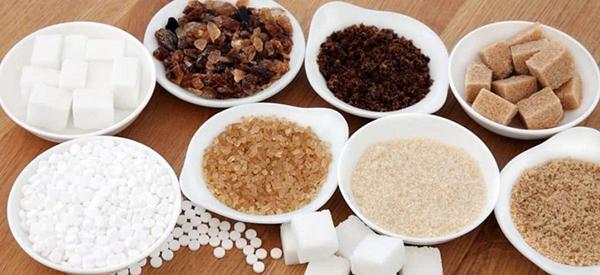
Sugar Substitutes for Diabetics: Five Sugars That are OK to Eat
More than 34 million Americans suffer from diabetes, and that number continues to grow every day. When you have diabetes your blood sugar levels are too high. This happens because your body isn’t producing enough insulin, the hormone that allows cells to absorb glucose, which is the sugar you eat, and convert it into energy.
With type 1 diabetes your body doesn’t produce any insulin but with type 2 your body still produces some insulin, just not enough. In either case, as a diabetic, it is important that you are always conscious of your sugar and carbohydrate intake. So, If you are one of the millions suffering from this disease, you may be wondering what besides traditional white table sugar you can use for sweetening your desserts and drinks. We are all familiar with artificial sweeteners like aspartame and saccharine but what choices do we have if we are looking for a more natural option? Luckily, several natural sweeteners are considered safe for diabetics.
Coconut Palm Sugar
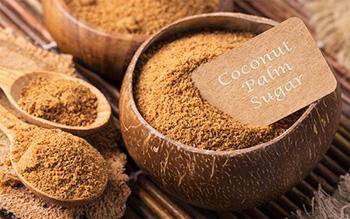 Coconut palm sugar comes from the sap of the coconut palm. While coconut sugar contains glucose and fructose, like traditional sugar, it has a lower glycemic index than other sugars. This makes it less likely to cause spikes in blood sugar that can cause so many problems for diabetics.
Coconut palm sugar comes from the sap of the coconut palm. While coconut sugar contains glucose and fructose, like traditional sugar, it has a lower glycemic index than other sugars. This makes it less likely to cause spikes in blood sugar that can cause so many problems for diabetics.
How it’s made: The sugar is made by heating the sap until all the moisture has evaporated. What remains is golden brown in color, and both looks and tastes similar to brown sugar. Coconut sugar tastes about as sweet as normal table sugar, so it is possible to use it in all the ways we would use regular sugar.
How to use it: Simply replace your sugar with coconut sugar and proceed normally. You may find you need to adjust baking times slightly but otherwise, the two sugars are pretty much interchangeable. This makes coconut sugar your most versatile option.
Monk Fruit Extract
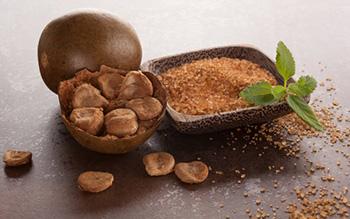 Monk fruit is a small round fruit native to SE Asia. Also known as the Buddha fruit or luo han guo, monk fruit has been used in traditional Chinese medicine for centuries. While monk fruit is very sweet, its sweetness does not come from fructose, glucose, or sucrose like most sweeteners. Monk fruit’s sweetness comes from unique antioxidants called mogrosides.
Monk fruit is a small round fruit native to SE Asia. Also known as the Buddha fruit or luo han guo, monk fruit has been used in traditional Chinese medicine for centuries. While monk fruit is very sweet, its sweetness does not come from fructose, glucose, or sucrose like most sweeteners. Monk fruit’s sweetness comes from unique antioxidants called mogrosides.
How it’s made: Monk fruit sweetener is made by first making a juice from the seeds and skin of the fruit. Then the juices are processed and dried into a powder. What remains, is a sugar-free, zero-calorie, natural powdered sweetener. Monk fruit extract can be 200-300 times sweeter than sugar, so you will need to adjust your recipes. Unfortunately, each brand of monk fruit extract is a different concentration so you will need to do some experimenting to find the right ratios with your recipes.
How to use it: Start by trying ⅓ a cup of monk fruit extract for every cup of table sugar. For sweetening drinks like coffee and tea, it can be easier to make a monk fruit syrup by dissolving the powder into water and making syrup. This can help with measuring small quantities. While monk fruit extract can be used in baked goods and to sweeten drinks like coffee or tea, it is not appropriate for fermented drinks as it doesn’t contain any sugars.
Yacon Syrup
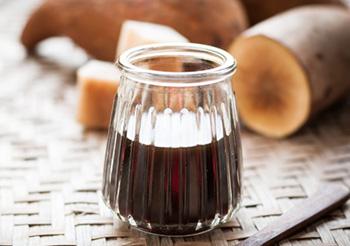 Yacon syrup is made from a tuber of the yacon plant, Smallanthus sonchifolius, native to the Andes. Similar to a potato, this tuber has eaten traditionally to help control diabetes. It is different from other tubers in that it contains mostly fructooligosaccharides (FOS), a type of sugar that is low in calories and does not raise blood glucose levels. In fact, yacon syrup has been shown to help improve insulin resistance.
Yacon syrup is made from a tuber of the yacon plant, Smallanthus sonchifolius, native to the Andes. Similar to a potato, this tuber has eaten traditionally to help control diabetes. It is different from other tubers in that it contains mostly fructooligosaccharides (FOS), a type of sugar that is low in calories and does not raise blood glucose levels. In fact, yacon syrup has been shown to help improve insulin resistance.
How it’s made: The syrup is made using an evaporator similar to the process for maple syrup. While yacon syrup is a great natural sweetener, there are some downsides to it. For some people, it can lead to digestive distress, so you will want to limit how much you use initially until you see how your body reacts.
How to use it: Don’t use more than two tablespoons to start. While it contains fewer calories than table sugar it is also less sweet so you will need to use more for the same level of sweetness. While it can be used in baking, I recommend starting to use it to sweeten drinks like coffee and tea until you see what you think of using it in larger quantities.
Date Sugar
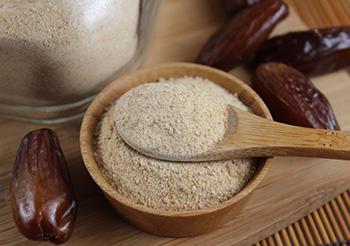 Date sugar should not be confused with date palm sugar.
Date sugar should not be confused with date palm sugar.
How it’s made: Date sugar is made by grinding dried dates, the fruit from the date palm, until they are a fine, granulated powder resembling brown sugar in texture and flavor. Date palm sugar is made from the sap of the palm tree and is more similar to traditional sugar. Since date sugar is made from the fruit, it contains all the benefits that dates have, including their natural sweetness. As this sweetness comes from fructose, as opposed to glucose, it has a lower glycemic index, which helps prevent spikes in blood sugar.
Also, it contains fiber helping your body absorb the sugars and carbs more slowly. These factors make it a good choice for diabetics. However, there are some limitations to date sugar. It does not dissolve in liquids or when baked.
How to use it: It is not a good option for adding to drinks like coffee, tea, or ferments like kombucha. But you can add it to your baked goods, with a one to one ratio for either granulated or brown sugar. It will add a rich, complex flavor making it great for crumbles and toppings. You can use it in cookies and cakes too.
Stevia
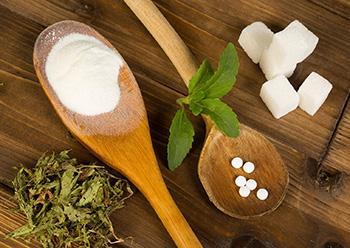 Stevia comes from the stevia plant, Stevia rebaudiana, native to Brazil and Paraguay. Like Monk Fruit, its sweetness does not come from sugars, but from certain compounds, called steviol glycosides, found in the plant. This makes it a zero-calorie sweetener that can be up 200 times sweeter than sugar.
Stevia comes from the stevia plant, Stevia rebaudiana, native to Brazil and Paraguay. Like Monk Fruit, its sweetness does not come from sugars, but from certain compounds, called steviol glycosides, found in the plant. This makes it a zero-calorie sweetener that can be up 200 times sweeter than sugar.
You can add leaves from the plant directly to add sweetness but they are often associated with a bitter aftertaste. Commercial stevia has been processed to a powder and removed the bitterness, though some people can still taste it.
How to use it: Stevia can be used to sweeten drinks like coffee and tea but is not suitable for ferments like kombucha. It can also be used in baking. It is much sweeter than regular sugar. If you are using baking stevia you will want to use ⅓ cup plus 1 ½ teaspoon for each cup of regular sugar. If you are using pure powdered stevia the ratio is much smaller, just 1 teaspoon equals a cup of sugar. Make sure you check exactly what kind of stevia you are using to ensure you get the right level of sweetness.
Many natural sweeteners are healthy for diabetics to consume. You may find that you want to have a couple of different options on hand for different purposes. Some are better for drinks, others for fermenting kombucha, and still others for baking. Experiment with several and find what works best for you and your needs.
You may also like:
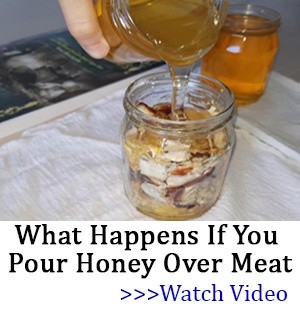 Herbal Coffee Substitutes You Can Drink Every Morning
Herbal Coffee Substitutes You Can Drink Every Morning
Erratic Blood Sugar? Never Eat This Veggie (Video)
9 Natural Remedies that People with Diabetes Will Find Useful
How to Use Avocado Seeds to Lower Blood Pressure and Cholesterol

Volumn of sugar in baking recipes is needed for rise and texture. You may have to add powdered milk or other ingredient to compensate for less sugar
why is it no one mentions Xylitol made from pine and birch trees and with no calories and is low glycemic?
I bought Xylitol and think there is no sweetness at all
Wow! Its wild how different our experience has been with xylitol! I wonder if brand makes difference? I do know its not easy to find. I get mine from Natures Sunshine Products. Oh well I think its great! And it actually is healthy for teeth and has been used for chrinic sinus issues. Mysterious stuff.
Xylitol is poisonous to dogs, very lethal which may be why it was not included.
I, too, like xylitol as an alternative sweetener. I don’t suffer any side effects from it. For some reason, I experience anxiety when I consume any products with stevia in them.
I use Stevia. Add xanthan gum for a bit of bulk, how i make my own jam. As far a Xylitol, have serious issues with it, why i don’t stock it or use it. The side effect hits me hard.
How do you make your own jam?
I use pomona brand rather than sure jel. Recipes in the box with whatever fruit. You may need to catch Sprouts or Whole foods for the pomona. These recipes can be made with little to no sugar. Since there is no bulk with stevia, thats when I add a very small amount of Xantham gum. That is a thickener that will gum. So, use sparingly, add to the fruit while it is cold. My daughter uses sure gel with out sweetener. That is doable too. But I’m not a fan of whats in sure gel. Hot jam in hot jars. use the water bath method for sealing the jars. That only needs a tall (think tamale) pot. Any kind of fruit you have. I’ll be making Strawberry, blackberry and maybe peach mango this year.
Thank you so much for answering me!!!
Can you give me some idea of how much Xantham Gum you use per recipe in the Pamona’s?
It’s been a while since I made jam. When talking Xantham Gum think 1/4 teaspoon or less. Make a cup of gravy from scratch, measure in with cold/room temp liquid. Blend then heat. Expect to use too much the first time or two. I’ve never seen written proportions.
Thank you again!
what side effect? I have heard that if there is too much candida yeast in the body it can give you diarrhea…Is that what you mean? I also was told you need to start with smaller doses and work up to it. PersonallyMy family and I have never had any trouble with it. too bad they left it off the list
Never heard of that reason for the side-effect. I’m going to look into monk fruit possibly for baking.
Are there studies supporting these statements regarding the low glycemic index and the harmlessness of their use to diabetic patients? Thank you in advance.
Yes. I read them some time ago when natures sunshine stated selling it. But i would goggle it as i do not have access to it now. I may still have a brochure on it and if so i will let you know what it says or send to you
Swanson.com has it. I have used it for many years. Their number is (800) 437-4148
What about agave?
Agave sweetener is made with heat and enzymes in the same way high fructose corn syrup is made which makes an unhealthy, overly refined sugar substitute.
I recently discovered “Bocha Sweet”. The information on the bag states: Kabocha is a superfood, … and 100% natural pentose that is utilized by the body …without the participation of insulin. zero glycemic and calories
What about apple sugar? What I’ve used comes in liquid form